Benedictine Values – Modern Monasticism.
A video project that various Benedictine communities have put together
for Catholic Sisters Week 2021.
You can also click on the link below to view the video.
Holy Name Monastery
Founded 1889
You can also click on the link below to view the video.
We are excited to share a video on March 8th in celebration of National Catholic Sisters Week. The video features the practices and ministries of several Benedictine monasteries across the country including the Benedictine Sisters of Florida. In addition to how catholic organizations honor women religious during March, this is the fifth year that they are part of National Women’s History Month. While Sisters and nuns do not seek recognition, making them a part of this annual celebration every March is only fitting.
Our country has been served since the early 1700s by Sisters and nuns who established exceptional schools and hospitals and have been remarkable in their out-reach to the poor. Their history is closely tied to the very development of our nation. Today there are 45,605 Sisters and nuns who are consoling, inspiring and praying for those who have lost loved ones during the Covid pandemic. Now as in so many past crises, vowed women are a God-send.
This year’s theme for National Women’s History Month is “Valiant Women of the Vote,” focusing on those who worked for women’s right to vote. Faith and religion played a significant role in the fight for fairness. Suffrage was not only a legal issue, but certainly a moral one. Journalist Elaine Weiss wrote “The Women’s Hour: the Great Fight to Win the Vote,” highlighting the fact that women of various faiths came together to organize and lobby. They saw suffrage as a matter of divine justice as well as human rights.
Continue Reading
Jesus took Peter, James and John and led them up a high mountain apart by themselves. … from a shining cloud a voice is heard … and Abraham answered “Here I am!” And, Peter said: Lord, it is good for us to be here – let us build a tent. In the words of Paul, I ask you: “If God is for us, who can be against us?”
This weekend we celebrate our 132nd founding “birthday.” As we recall the beginnings of our community here in central Florida, those snippets I read from this weekend’s Scriptural readings – arranged to suit this writer – sketch out the story of our founding Sisters quite nicely. My challenge is to be true to the history of 132 years without diminishing its impact as I condense it to a few printed pages. So, I’m giving you the “Reader’s Digest” or “Cliff Notes” version of the story I know.
The year was 1889. From central Florida, the voice of God spoke in the guise of Father Gerard Pilz: “Please come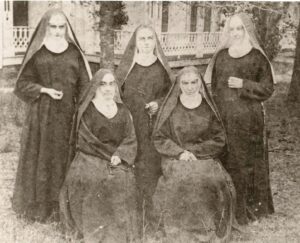 and educate these children.” A Sister-friend said: yes – let me see who will join me. In a document dated February 15, 1889, Bishop Phelan of Pittsburgh and Bishop Moore of Florida and Mother Adelgunda agreed and said to the Sisters: “Know that you give up all claims on the Pittsburgh community – Go in peace.” That was on February 15th. By the evening of February 24th, Dolorosa gathered Boniface, Josephine and Agatha for a transfer of vows ritual that Agnes witnessed. Later, she said “Wait for me, I’m coming, too.”
and educate these children.” A Sister-friend said: yes – let me see who will join me. In a document dated February 15, 1889, Bishop Phelan of Pittsburgh and Bishop Moore of Florida and Mother Adelgunda agreed and said to the Sisters: “Know that you give up all claims on the Pittsburgh community – Go in peace.” That was on February 15th. By the evening of February 24th, Dolorosa gathered Boniface, Josephine and Agatha for a transfer of vows ritual that Agnes witnessed. Later, she said “Wait for me, I’m coming, too.”
On February 25, 1889 there was a 6’ snowfall when the troop boarded the train as it left Alleghany County, PA. They arrived travel-worn, feeling bouts of fear, excitement and hesitation, in San Antonio, Florida three days later on February 28, 1889, where it was a toasty 80 degrees. The townsfolk hadn’t quite finished the renovations on their future home so the Sisters stayed a stone’s throw away in the Dallas House just outside the town square.
Now you’ll recall that Peter, James and John went UP a mountain with Jesus. These ladies traveled, DOWN…down south and south some more to almost the tip of the south-eastern-most state in the union. DOWN below the southern tip of an area commonly referred to as the “Bible belt.”
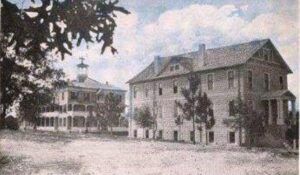 Jesus told his disciple, “Tell the vision to no one.” These Sisters were informally commissioned to “spread the news everywhere.” Beginning the day after their arrival, they founded Holy Name Academy, their first school in their home and assumed administration of Saint Anthony Parish School, March 1, 1889 and shortly thereafter the school three
Jesus told his disciple, “Tell the vision to no one.” These Sisters were informally commissioned to “spread the news everywhere.” Beginning the day after their arrival, they founded Holy Name Academy, their first school in their home and assumed administration of Saint Anthony Parish School, March 1, 1889 and shortly thereafter the school three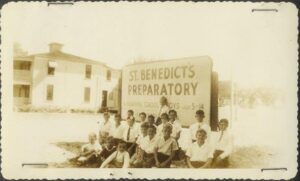 miles away in St. Joseph. From 1929 to 1959, the community also operated St. Benedict Prep School for boys too young to attend the nearby Abbey school. These ladies in strange long black dresses, riding on a donkey, were known to pay “pop in” visits on farmers and ranchers, absent school children and Sunday Mass absentees. They fed the hungry, looked after the sick and buried the dead.
miles away in St. Joseph. From 1929 to 1959, the community also operated St. Benedict Prep School for boys too young to attend the nearby Abbey school. These ladies in strange long black dresses, riding on a donkey, were known to pay “pop in” visits on farmers and ranchers, absent school children and Sunday Mass absentees. They fed the hungry, looked after the sick and buried the dead.
In the long view of history, this growing band of visionaries who just could not say NO, were involved in all levels of education: early ed to college, adult education and tutoring programs. They were teachers, drama directors, musicians, school bus drivers, coaches for debate and sports teams. They established a litany of schools as well as weekend and summer catechetical programs in: Quincy, Ocala, Inverness, Floral City, Leesburg, Dade City, Brooksville, DeLand; Deer Lake Camp, Good Counsel Camp, Camp Lake Jovita. There were schools in honor of a roll call of saints: Holy Family, St. Anthony and St. Paul, Santa Fe, St. Lawrence and St. Martha. St. Boniface in Olfen, TX, St. Teresa in New Orleans, St. Margaret Mary and Our Lady of Lourdes in Slidell, LA and Annunciation in Bogalusa, MS. In 1902 three of the Florida foundresses (and two others, one a postulant, later a prioress, Mother Annunciata) again said yes to a voice calling them into service. Along with Benedictine women from Covington, KY they answered the plea of the Bishop of Birmingham, AL to make a new foundation that today thrives in Cullman, AL.
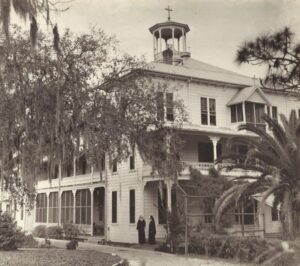 In 1911, the three-story – once-hotel, now Holy Name Convent – was suspended on logs and pulled by oxen for the move from San Antonio plaza, a ½ mile up an incline to the shores of Lake Jovita. The story is relatively routine for the intervening years until 1930 when there was an infusion of eight young, energetic postulants. Several more candidates entered after WWII and the community grew to 65 members by the late 1950s. By then, certification was required of all teachers in any educational setting: public or faith-based. Our Sisters took weekend and night classes (no on-line, virtual classes in those days!). They crammed as many courses as possible into what we’d laughingly call “summer vacation” time. Some were released to “go away” for a semester or a year or so to further their education.
In 1911, the three-story – once-hotel, now Holy Name Convent – was suspended on logs and pulled by oxen for the move from San Antonio plaza, a ½ mile up an incline to the shores of Lake Jovita. The story is relatively routine for the intervening years until 1930 when there was an infusion of eight young, energetic postulants. Several more candidates entered after WWII and the community grew to 65 members by the late 1950s. By then, certification was required of all teachers in any educational setting: public or faith-based. Our Sisters took weekend and night classes (no on-line, virtual classes in those days!). They crammed as many courses as possible into what we’d laughingly call “summer vacation” time. Some were released to “go away” for a semester or a year or so to further their education.
Then, began a new flurry of activity. In 1959, the place the Sisters called home and housed the girls’ boarding school, was declared by code unfit for occupancy. Result – Sisters and the girls were temporarily housed at St. Anthony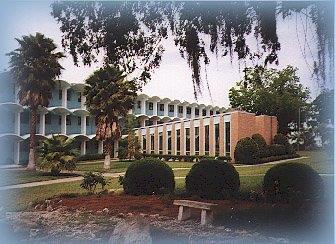 School and with some families in town. The “old building” was demolished and a new Holy Name Priory was erected just across the original driveway. In a short span of time, the Benedictine Sisters began collaboration with the monks of Saint Leo Abbey to extend the abbey prep school program to junior college level and later the four-year college – before long, a university. We built new facilities to house college women and provide meals for coed students. Right around this time, the Sisters joined the Congregation of St. Scholastica. This was all new, and with our house so geographically distant from other Benedictine communities – well, we tootled along as usual, making decisions as we were accustomed to – the council said, so Mother said and things happened. Thus it was that one day, Sister Carmen was on the phone with Mother Mary Frances (congregation president). She could hear the sound of construction in the background and asked what was going on. When Sister Carmen replied, “That’s the new dorm going up.” “Oh, my dear, now that you are in the congregation, our council is supposed to review your plans so we know you won’t go into debt.” (Sometimes it’s just seems better to ask forgiveness than to ask permission.)
School and with some families in town. The “old building” was demolished and a new Holy Name Priory was erected just across the original driveway. In a short span of time, the Benedictine Sisters began collaboration with the monks of Saint Leo Abbey to extend the abbey prep school program to junior college level and later the four-year college – before long, a university. We built new facilities to house college women and provide meals for coed students. Right around this time, the Sisters joined the Congregation of St. Scholastica. This was all new, and with our house so geographically distant from other Benedictine communities – well, we tootled along as usual, making decisions as we were accustomed to – the council said, so Mother said and things happened. Thus it was that one day, Sister Carmen was on the phone with Mother Mary Frances (congregation president). She could hear the sound of construction in the background and asked what was going on. When Sister Carmen replied, “That’s the new dorm going up.” “Oh, my dear, now that you are in the congregation, our council is supposed to review your plans so we know you won’t go into debt.” (Sometimes it’s just seems better to ask forgiveness than to ask permission.)
And the “rest of the story” ??? Most of us in this room are the “rest of the story” …years of decisions, chapel renovations and praying in the parlor, spreading to unused space than down-sizing, planning and building and moving, welcoming candidates and saying good-byes; jubilees and funerals, galas and retreats … the list goes on. And, here we are 48, 212 days after those four adventurous souls (remember one that we call foundress didn’t come until June). We live assured, that with every venture we consider, the words of Paul in the second reading are our firm foundation: “If God is for us, who can be against us?” If God is in this, if this is God’s will, if this is the voice of God from the cloud, a rainbow of blessings will be there for us. And we can say with Peter: “Lord, it is good for us to be here.”
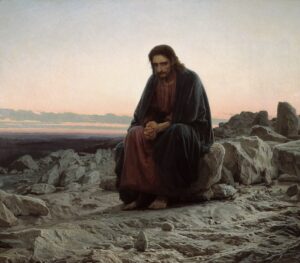 In the liturgical cycle of readings, this Gospel from Mark was originally only two verses – later the church added two more – but it is still one of the shortest Sunday readings. It tells us only that, immediately after His baptism, Jesus was led into the desert by the Spirit to be tempted by the devil, for 40 days. You’ll notice that Mark, unlike Luke and Matthew, does not outline for us the three temptations of Jesus. He simply lets us know that the conflict between Jesus and Satan only begins in the desert. The ultimate test will be in Jesus’ final hours on the cross.
In the liturgical cycle of readings, this Gospel from Mark was originally only two verses – later the church added two more – but it is still one of the shortest Sunday readings. It tells us only that, immediately after His baptism, Jesus was led into the desert by the Spirit to be tempted by the devil, for 40 days. You’ll notice that Mark, unlike Luke and Matthew, does not outline for us the three temptations of Jesus. He simply lets us know that the conflict between Jesus and Satan only begins in the desert. The ultimate test will be in Jesus’ final hours on the cross.
We are now four days into our Lenten journey of 40 days. We are reminded of Elijah who journeyed in a desert 40 days and nights, making his way to Mount Horeb as well as the Israelites who wandered in a desert for 40 years. Benedict knew that deserts are an unavoidable part of life. We have to pass through them – not get stuck in them. In the desert, we soon find out we are too weak to go it alone. According to St. John Chrysostom: “The Spirit drags Jesus into the desert, since he wanted to draw the devil there – and Jesus gave occasion to him not only on account of his hunger but also on account of the place: for then most especially does the devil attack when he sees people isolated and by themselves.” No wonder Benedict urges us not to be isolated in our Lenten journey: “the entire community during these days of Lent (together strives) to keep the manner of life most pure.”
We’ve heard the expression “practice makes perfect” so often that the meaning may have lost its impact on us. Each year at the beginning of Lent we may feel like that skater or a musician who’s been laid up for a year without practice. As Benedict says in Chapter 49 of the Rule, during Lent we are called to be the kind of person we should be every day. Lent gives us a jump-start of courage to pick up the practices that will support the values we profess and hold dear. The biggest temptation most of us have to face it to “give up” because we stumble. What would you think if you dialed a wrong number and got this recording: I’m not available right now, but I do thank you for caring enough to call me.” (How sweet!) But, it continues: “I am making some changes in my life. Please leave a message after the beep. If I do not return your call, you are one of the changes.”
Thomas à Kempis, in the IMITATION OF CHRIST, says, “Often we do not know what we can stand, but temptation shows us what we are. Above all, we must be especially alert against the beginnings of temptation, for the enemy is more easily conquered if refused admittance to the mind and is met beyond the threshold when it knocks…. A person, indeed, is not worthy of the sublime contemplation of God who has not been tried by some tribulation for the sake of God. For temptation is usually the sign preceding the consolation that is to follow.”
Lent is God’s call to us to make God and Godly values the center of our life. It is a time for honesty and stability. A time for us to be close to God. The desert of life, of Lent – like any desert – can be a vast expanse of sand and rock, punctuated by ragged hills, blistered by a relentless sun, a barren land in which little grows. But, depending on our outlook, the space can be filled with mysterious unexpected experiences. It can be a place not only of testing but of beauty where faith can grow. Mirages give us false hope. A welcome pool of water or a dripping cactus can reveal to us, in the blink of an eye, a reflection of what we really look like. During Lent we are simply being asked to dare to be convinced that this is a wonderful opportunity to rediscover our true self-worth and the wonder of being the child of a loving God. We are challenged not to focus on the storm clouds of COVID restrictions, chronic health conditions, what we DON’T have. We do well to focus on all that we DO have: our faithful supporters, the friends who DO make contact, the companions who DO treat us gently, our God who, even with all the concerns and pleas that are raised for attention, remembers ME and loves ME with unfailing love.
Personal deserts are unavoidable, they’re part of life. We need Christ and we need the ministry of others. If for nothing else than to teach lessons of dependence. We’ll never be as strong or wise as we’d like. We need the grace of God in Christ. We need the ministry of each other and all of God’s people to strengthen us by their prayerful support and good example that we, too, might take up our crosses and follow Jesus. We pray that like that voice message said (I mentioned earlier), we do take the opportunity of Lent to make changes on our lives. But unlike that voice message, may we never hear God’s voice and choose not to return the call.
Next Sunday we will be commemorating the 132nd anniversary of the founding of Holy Name Convent from Pittsburgh, PA. You can look for a snippet of our history as the reflection. God bless our founding Sisters! Their first home was “on loan” space in a family home in San Antonio which is the township adjacent to Saint Leo, home of the current monastery. The weather bureau archives reveal that it was 80 degrees in San Antonio, FL on the day of their arrive, February 28, 1889. Stay tuned for the “rest of the story” next week.

Continue Reading
PO Box 2450
12138 Wichers Road
St. Leo, FL 33574-2450
(352) 588-8320
(352) 588-8443
